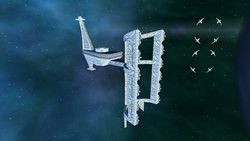
|
This wiki is closed in favour of the new wiki. Information shown is likely to be very out of date. |
Roppongi Station
| Roppongi Station | |
| Akebono class Station | |
| Owner | |
| Interspace Commerce | |
| Location | |
| 6D, New Tokyo | |
| Technical Data | |
| Gravity | Complete |
| Docking bays | Yes |
| Amenities | Yes |
| Crew | 1,320 |
In the early years of the Kusari Empire, foreign immigration was strictly controlled and permanent foreign settlements on New Tokyo were strictly forbidden. While the Kusari Shogunate was unwilling to bend these rules, it still accommodated foreign business interests by allowing Interspace Commerce to construct Roppongi Station in 318 A.S. Despite the restrictions placed on permanent residencies elsewhere in Kusari, and the outrage expressed by conservative Kusari politicians at the Hideyoshi controlled Shogunate for allowing foreigners into the New Tokyo system, Roppongi Station's business flourished, with many corporations opening offices onboard.
When Emperor Hideyoshi was deposed in 321 A.S., Roppongi's future was plunged into doubt. Thankfully, even the conservatives had recognised(sic) the financial benefits of leaving it alone, and in any case they had no desire at the time to upset Interspace Commerce, who owned the rights to all the Jump Gates and Trade Lanes within Kusari. The conservatives were still reluctant to have too many foreigners in New Tokyo, however, and Deshima Station in Shikoku was eventually constructed in 350 A.S. with the aim of reducing the "outsider" population. Strict travel regulations were enforced for ships entering into New Tokyo.
Most of these restrictions have since been lifted in the interests of progress. Roppongi has become a busy trade center, with Kusari and foreign companies arranging business deals on the station, almost around the clock. Most of the major houses have also established their embassies on Roppongi.
Missions Offered
| [show]Spoiler: |
|---|
Bribes Offered
| [show]Spoiler: |
|---|
Commodities
| Exports |
| Imports |
| Imports |
Ships
|
|

